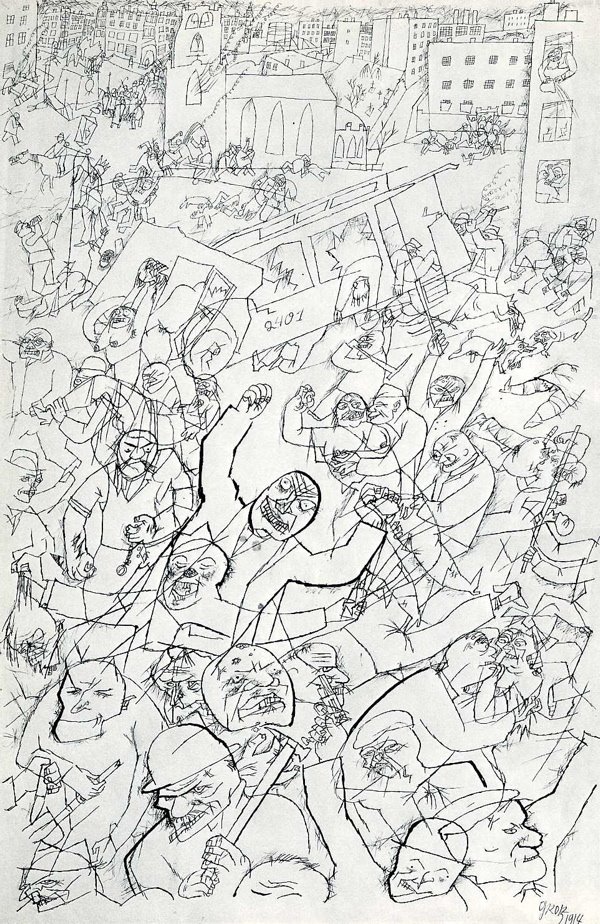A little info on Otto Dix, the creator of this week’s image, “Prager Street.”
From Wikipedia: Otto Dix (December 2, 1891 - July 25, 1969) was a German painter and printmaker. Noted for his ruthless depictions of Weimar society and of the brutality of war, he is one of the most important artists of the Neue Sachlichkeit (New Objectivity).
Dix was an interesting character. He was a decorated German military officer during the WWI (where he was wounded several times), but made a name for himself after the war as an avant garde artist of the Dadaist sort. He was prolific through the 1920s, but was deemed a degenerate artist by the Nazis, who burned a number of his paintings. He was employed by the Nazi government to paint properly German landscapes, conscripted to serve the Motherland during WWII, captured by the French, and eventually left to live out his life in post-war Europe, where he continued to detail the lives of those that the war spared, however maimed.
 Especially impressive are Dix’s “War” etchings, which he completed in 1924, many of which can be seen here. These etchings, which are indebted to Goya's war paintings, don't flinch from the ugliness of warfare. They include depictions of ariel bombing, rape, chemical warefare, and disfigurement. As etchings, these pieces avoid the trap of over-aestheticizing --and thus glorifying--the bodies mangled by the war. (See "Meal Time in the Trenches," left.)
Especially impressive are Dix’s “War” etchings, which he completed in 1924, many of which can be seen here. These etchings, which are indebted to Goya's war paintings, don't flinch from the ugliness of warfare. They include depictions of ariel bombing, rape, chemical warefare, and disfigurement. As etchings, these pieces avoid the trap of over-aestheticizing --and thus glorifying--the bodies mangled by the war. (See "Meal Time in the Trenches," left.) The "War" etchings differ from much of Dix's output, which often features multimedia (collage) and vibrant colors. Whereas the "War" series works under an obligation to the physical reality of the times, much of Dix's work combines an adherence to the physical realities of post-war Europe with a kind of neurotic, grotesque and even nightmarish perspective that highlights the interior, psychological aspects of inter-war Europe. On the right is a painting entitled, "The Skat Players," from 1920. It depicts several military officers engaging in mundane activity--playing cards--but irrevocably disfigured. Arms, eyes, legs, noses, and even a heart are replaced by the machinery of Europe, which has atomized them.
The "War" etchings differ from much of Dix's output, which often features multimedia (collage) and vibrant colors. Whereas the "War" series works under an obligation to the physical reality of the times, much of Dix's work combines an adherence to the physical realities of post-war Europe with a kind of neurotic, grotesque and even nightmarish perspective that highlights the interior, psychological aspects of inter-war Europe. On the right is a painting entitled, "The Skat Players," from 1920. It depicts several military officers engaging in mundane activity--playing cards--but irrevocably disfigured. Arms, eyes, legs, noses, and even a heart are replaced by the machinery of Europe, which has atomized them. Even where his work is not explicitly filled by the content of war, as in his portraits, there is an uncanny oddness to his work (some great examples can be seen here). Often set amid unfamiliar backdrops, the subjects of his portraits evince a kind of inner stupidity or madness, as slumping bodies project blank expressions toward the viewer. In some paintings, we leave the sad world of the war's practitioners and enter the even sadder world of the aristocracy, whose ugliness is perhaps even more jarring than the spectacle of the victim.
Even where his work is not explicitly filled by the content of war, as in his portraits, there is an uncanny oddness to his work (some great examples can be seen here). Often set amid unfamiliar backdrops, the subjects of his portraits evince a kind of inner stupidity or madness, as slumping bodies project blank expressions toward the viewer. In some paintings, we leave the sad world of the war's practitioners and enter the even sadder world of the aristocracy, whose ugliness is perhaps even more jarring than the spectacle of the victim.Dix's work veers close to Surrealism at times, and as the years went on, he lost some of the modernist flare that gave his paintings their power. But on the whole, he left a tremendous legacy testifying to a world riven by its inability to control the the tools of modernity that it had forged.
I offer this tiny history here both for my own benefit and for the education of any readers I may have. My feeling is that we don't live in a time so different from Dix's, and that though in the Empire we aren't confronted by casualty every day, it still infects us. With just a little focussed looking, you can see it.
Dix is all over the internet, but here's one more gallery that has a nice range of his work.



4 comments:
I am studying Otto's art works, they are quite fascinating at times marvellous to watch.
I love his work, what a really interesting character. Long live to degenerate art!
He's never seemed more relevant.
Post a Comment